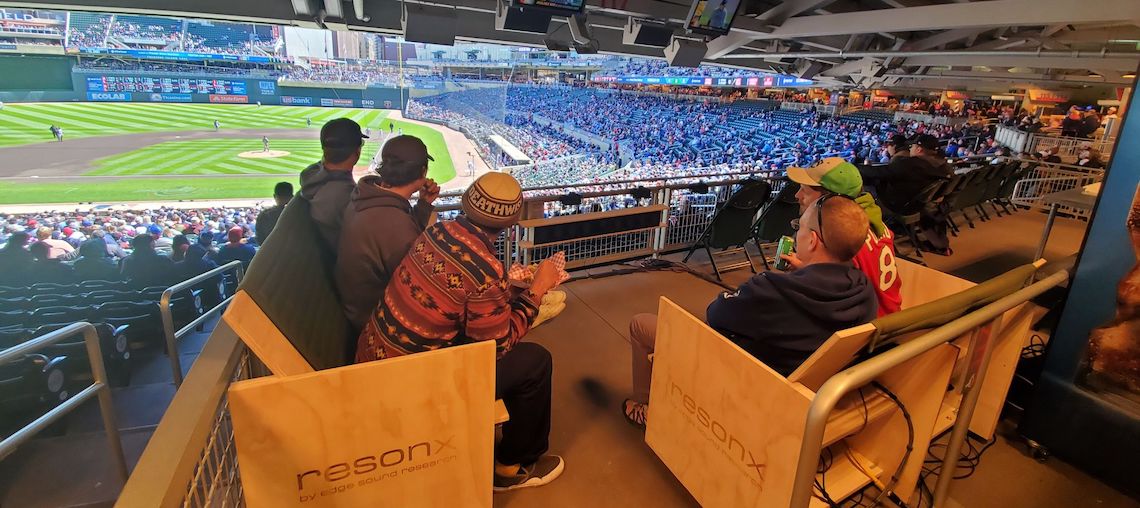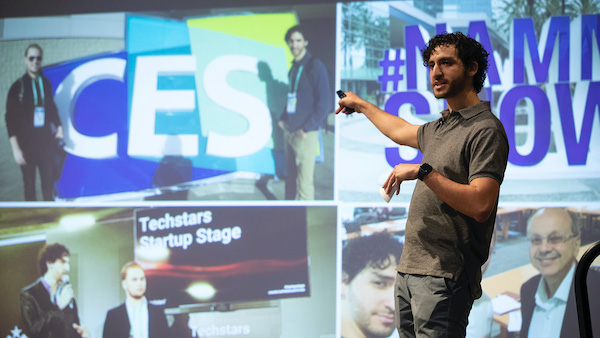
In 2022, the Minnesota Twins partnered with Edge Sound Research to create the ResonX Sound Lounge, allowing spectators to “feel” the sounds of the ballpark through vibrations in the seats. ResonX photo
Written by Ben Hensley
“As long as you don’t go into music, you’ll be fine.”
That was the light-hearted humor the doctor of a young Ethan Castro offered. Castro, a Fresno native, met with countless doctors throughout his early life, attempting to correct hearing-related issues caused by a premature birth.
Several decades later, 29-year-old Castro hopes his success in not only music but audio technology will provide a new and unique means of interpreting sound for the deaf and hard-of-hearing community.
The challenge
By age 3, Castro suffered more than a dozen ear infections that often set in due to moisture in the air. By age 6, he developed scar tissue in his ears from the placement of three different sets of tubes to prevent fluid buildup. While the tubes may have helped prevent moisture, they unfortunately also prevented Castro’s eardrums from vibrating normally, leading to his inability to hear certain frequencies.
This didn’t stop Castro from becoming interested in music; at a young age, he would rest his leg against his father’s car speaker in order to “feel” the music in ranges he could not consistently hear.
Throughout his youth, Castro worked with speech therapists at Fresno State’s Speech Language Pathology program to improve his ability to communicate effectively despite his hearing limitations.
“As a teenager I kind of figured out enough, and then I was able to start living more normally from high school and up,” Castro said, adding that he often was able to interpret his friend’s and family’s conversations based on his previous interactions with them — often “presuming” what they would say.
Despite his diagnosis, music was a central part of Castro’s life. Castro attended University High School, a charter school on the Fresno State campus that focuses heavily on music and the arts, requiring prospective students to have two years of music instruction to apply.
Castro graduated from University High School and enrolled at Fresno State as a music major, defying his doctors’ predictions and eventually graduating with his B.A. in music theory and composition, and receiving his M.A. in music industry administration from CSU, Northridge.
An ‘edge’ to sound tech
In 2017, Castro enrolled in UC Riverside’s Ph.D. program in digital composition, focusing his research on the theory that audio experiences can be felt as well as heard. Through vibrations, he could help others with hearing difficulties experience sound in a more “complete” way by feeling what others are naturally able to hear.
The technique was simple yet innovative — attach “exciters” to a chair which enable the seat to vibrate at different frequencies based on the focused sounds in a particular atmosphere.
In 2019, Castro and future co-founder Valtteri Salomaki worked together to obtain a grant to start the company after Salomaki was impressed by what Castro pitched as a dissertation project.
The duo presented their product at the annual Consumer Electronics Show (CES) in Las Vegas in January 2020, where their idea both excited and intrigued the audience. Despite initial skepticism, the duo continued their development and 15 months later, designed the first 3D ResonX prototype.
By the 2022 CES showcase in Las Vegas, Edge Sound Research was ready to showcase its technology and bring the ability to “hear” in a unique way to clients in ways never before imagined.
On opening day in 2022, the Minnesota Twins debuted Edge Sound Research’s ResonX Sound Lounge at Target Field, allowing fans to not only hear the sound, but feel it.
“We were one of just two companies to actually make a deal with the Twins,” Castro said. “They believed that we had something that could change their fan experience.”
The Twins were seeking a mobile lounge that they could move throughout the stadium to experience Edge Sound’s product.
“We worked with their audio team to condition the signal a little bit,” Castro said. “A baseball cracking is not in the lower register that we’re used to feeling…unless you hit it just the right way.”
Castro, a percussionist himself, said that similar to a drum beat, there is a different resonance projected based on where the baseball is hit.
The NBA is also exploring Edge Sound’s product, incorporating its tech into the basketball world through the NBA Launchpad Program which, similar to the Twins’ program, searches for innovative options for additional fan inclusion and immersion.

Returning to the Silent Garden
Castro was recently featured in the Silent Garden Lecture Series at Fresno State, showcasing his patent-pending audio technology for the first time in California.
In 2008, the Silent Garden was formed at Fresno State by Dr. Paul W. Ogden, the author of “The Silent Garden: Raising Your Deaf Child.” The goal of the organization is to assist individuals and families with deaf and hard-of-hearing children to be able to communicate more effectively despite their condition.
Castro, whose mother attended Fresno State and served as a hard-of-hearing teacher, formed a close relationship with the group, as well as other groups in the Central Valley that provide assistance to the hard-of-hearing community.
Unfortunately, Castro said that despite years of technological advancements, audiology has worked primarily on fixing the problem as opposed to finding alternative solutions for inclusivity and accessing sound in unique ways.
“I would love to say there’s a huge difference from when I was growing up, but unfortunately, there really hasn’t been a huge shift in assistive technologies for hearing because there’s been no fundamental shift in how we hear technology,” Castro said.
Similar to the way glasses will help “crispen” vision, but not add color to a colorblind user, standard hearing aid and audiology equipment focus primarily on amplification as opposed to alternative means of interpreting sound.
“No matter how crisp the glasses help you see, if you can’t see color, then it’s not going to help with visualizing or identifying something through vision,” Castro said. “If you’re completely missing bands of frequencies [in sound], the best hearing aid in the world is not going to help you recover that.”
With both the MLB and NBA showing interest, Castro hopes the unique approach to hearing assistance will become more widespread in the hearing-impaired community.








